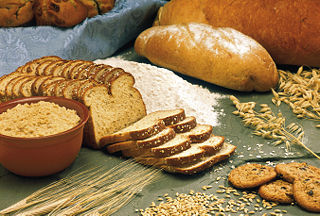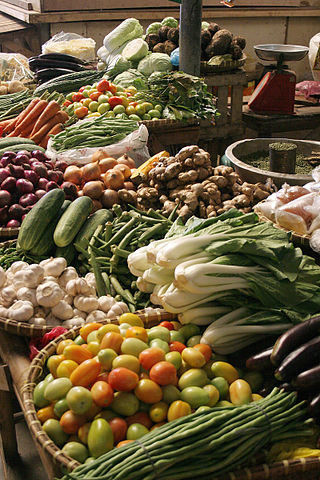
A food pyramid is a representation of the optimal number of servings to be eaten each day from each of the basic food groups. The first pyramid was published in Sweden in 1974. The 1992 pyramid introduced by the United States Department of Agriculture (USDA) was called the "Food Guide Pyramid" or "Eating Right Pyramid". It was updated in 2005 to "MyPyramid", and then it was replaced by "MyPlate" in 2011.

The Healthy Eating Pyramid is a nutrition guide developed by the Harvard School of Public Health, suggesting quantities of each food category that a human should eat each day. The healthy eating pyramid is intended to provide a more sound eating guide than the widespread food guide pyramid created by the USDA.

A healthy diet is a diet that maintains or improves overall health. A healthy diet provides the body with essential nutrition: fluid, macronutrients such as protein, micronutrients such as vitamins, and adequate fibre and food energy.

A school meal is a meal provided to students and sometimes teachers at a school, typically in the middle or beginning of the school day. Countries around the world offer various kinds of school meal programs, and altogether, these are among the world's largest social safety nets. An estimated 380 million school children around the world receive meals at their respective schools. The extent of school feeding coverage varies from country to country, and as of 2020, the aggregate coverage rate worldwide is estimated to be 27%.

A food group is a collection of foods that share similar nutritional properties or biological classifications. Lists of nutrition guides typically divide foods into food groups, and Recommended Dietary Allowance recommends daily servings of each group for a healthy diet. In the United States for instance, the USDA has described food as being in from 4 to 11 different groups.

A serving size or portion size is the amount of a food or drink that is generally served.

Vegetables are parts of plants that are consumed by humans or other animals as food. The original meaning is still commonly used and is applied to plants collectively to refer to all edible plant matter, including the flowers, fruits, stems, leaves, roots, and seeds. An alternative definition of the term is applied somewhat arbitrarily, often by culinary and cultural tradition. It may exclude foods derived from some plants that are fruits, flowers, nuts, and cereal grains, but include savoury fruits such as tomatoes and courgettes, flowers such as broccoli, and seeds such as pulses.
The European Prospective Investigation into Cancer and Nutrition (EPIC) study is a Europe-wide prospective cohort study of the relationships between diet and cancer, as well as other chronic diseases, such as cardiovascular disease. With over half a million participants, it is the largest study of diet and disease to be undertaken.
The Dietary Guidelines for Americans (DGA) provide nutritional advice for Americans who are healthy or who are at risk for chronic disease but do not currently have chronic disease. The Guidelines are published every five years by the US Department of Agriculture, together with the US Department of Health and Human Services. Notably, the most recent ninth edition for 2020–25 includes dietary guidelines for children from birth to 23 months. In addition to the Dietary Guidelines per se, there are additional tools for assessing diet and nutrition, including the Healthy Eating Index (HEI), which can be used to assess the quality of a given selection of foods in the context of the Dietary Guidelines. Also provided are additional explanations regarding customization of the Guidelines to individual eating preferences, application of the Guidelines during pregnancy and infancy, the USDA Nutrition Evidence Systematic Review, information about the Nutrition Communicators Network and the MyPlate initiative, information from the National Academies about redesigning the process by which the Dietary Guidelines for Americans are created, and information about dietary guidelines from other nations.
Fruits & Veggies – More Matters is a national public health initiative from Produce for Better Health Foundation and Centers for Disease Control and Prevention (CDC) to increase the consumption of fruits and vegetables. This campaign, begun in 2007, took the place of the 5 A Day program. The shift was implemented in order to better communicate updated dietary guidelines, which recommended more than five servings of fruits and vegetables for some Americans.
Canadian health claims by Health Canada, the department of the Government of Canada responsible for national health, has allowed five scientifically verified disease risk reduction claims to be used on food labels and on food advertising. Other countries, including the United States and Great Britain, have approved similar health claims on food labels.
Nutrition education is a set of learning experiences designed to assist in healthy eating choices and other nutrition-related behavior. It includes any combination of educational strategies, accompanied by environmental supports, designed to facilitate voluntary adoption of food choices and other food and nutrition-related behaviors conducive to health and well-being. Nutrition education is delivered through multiple venues and involves activities at the individual, community, and policy levels. Nutrition Education also critically looks at issues such as food security, food literacy, and food sustainability.
Wholesome Wave is a U.S. nonprofit organization that creates partnership-based programs that enable underserved consumers to make healthier food choices by increasing affordable access to health, locally and regionally grown foods. The organization addresses complex problems through simple solutions with a vision towards healthy, affordable food for all. Wholesome Wave operates two nutrition incentive programs, the Double Value Coupon Program and the Fruit & Vegetable Prescription Program, which tackle the issue of affordability for underserved consumers. Accessibility is emphasized through their supply chain work with food hubs, retail outlets and convenience stores. Wholesome Wave's innovative programs address the complex issues of food insecurity, farm viability, economic vitality of local communities, and diet-related diseases. Wholesome Wave was founded in 2007 by Michael Batterberry, Gus Schumacher and Michel Nischan.

MyPlate is the current nutrition guide published by the United States Department of Agriculture's Center for Nutrition Policy and Promotion, and serves as a recommendation based on the Dietary Guidelines for Americans. It replaced the USDA's MyPyramid guide on June 2, 2011, ending 19 years of USDA food pyramid diagrams. MyPlate is displayed on food packaging and used in nutrition education in the United States. The graphic depicts a place setting with a plate and glass divided into five food groups that are recommended parts of a healthy diet. This dietary recommendation combines an organized amount of fruits, vegetables, grains, protein, and dairy. It is designed as a guideline for Americans to base their plate around in order to make educated food choices. ChooseMyPlate.gov shows individuals the variety of these 5 subgroups based on their activity levels and personal characteristics.
The history of USDA nutrition guidelines includes over 100 years of nutrition advice promulgated by the USDA. The guidelines have been updated over time, to adopt new scientific findings and new public health marketing techniques. The current guidelines are the Dietary Guidelines for Americans 2015–2020 and have been criticized as not accurately representing scientific information about optimal nutrition, and as being overly influenced by the agricultural industries the USDA promotes.

The Farmers' Market Nutrition Program (FMNP) is a federal assistance program in the United States associated with the Special Supplemental Nutrition Program for Women, Infants and Children that provides fresh, unprepared, locally grown fruits and vegetables and nutrition education to WIC participants. Women, infants and children that have been certified to receive WIC program benefits or who are on a waiting list for WIC certification are eligible to participate in the FMNP.

The Partnership for a Healthier America (PHA) is a nonprofit organization created in conjunction with - but separate from - former First Lady Michelle Obama's Let's Move! effort in 2010. PHA works with the private sector to transform the food landscape in pursuit of health equity. Mrs. Obama currently serves as PHA's honorary chair, and alongside Higher Ground Productions, launched the Pass the Love w/ Waffles + Mochi campaign on March 10, 2021, with PHA to raise funds to aid in the distribution of 1 million meals to families in need around the country. Inspired by the Netflix series Waffles + Mochi, the campaign also raises awareness about food equity.
Research into food preferences in older adults and seniors considers how people's dietary experiences change with ageing, and helps people understand how taste, nutrition, and food choices can change throughout one's lifetime; particularly when people approach the age of 70, or beyond. Influencing variables can include: social and cultural environment, gender and/or personal habits, and also physical and mental health. Scientific studies have been performed to explain why people like or dislike certain foods and what factors may affect these preferences.
National Fruits & Veggies Month is a national observance and awareness campaign held in the United States during the month of September to educate about the health benefits of eating fruits and vegetables and to celebrate in song and culture how they are grown, distributed, and consumed. The awareness campaign consists of outreach to grocery stores and retailers and to schools and public organizations, outreach to nutritionists and other health professionals, weekly online contests with prizes, social media campaigns and logowear, and other special events during September to celebrate National Fruits & Veggies Month and inspire people to regularly consume fruits and vegetables and to create a more balanced lifestyle. The 'Take the Have A Plant pledge' is to "add one more fruit or vegetable to your routine, everyday this month." The year-long campaign surrounding 'Have a Plant' has monthly educational themes to be implemented by their Fruit and Vegetable Ambassadors in Action (FVAA) network.










